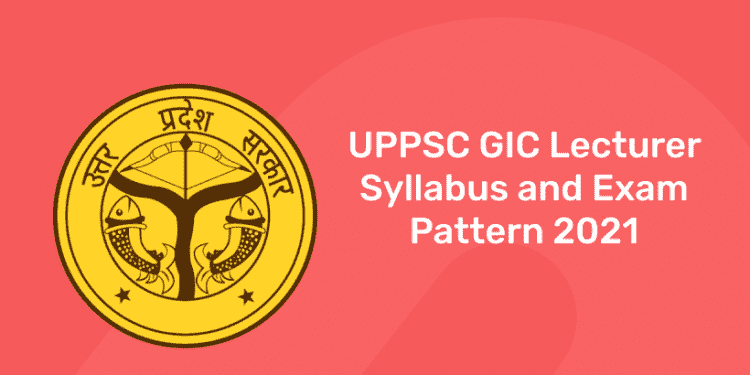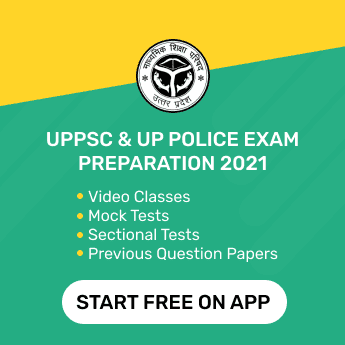Table of Contents
The Uttar Pradesh Public Service Commission will be recruiting GIC lecturers in the organisation, however, to successfully get a job in the Uttar Pradesh Public Service Commission you will have to pass the examination which will be conducted by the authorities to select the candidates. To successfully crack the examination, the candidates must have perfect knowledge regarding the UPPSC GIC exam pattern and UPPSC GIC lecturer syllabus 2021. Given below are the important details regarding the UPPSC GIC Lecturer Syllabus and Exam Pattern 2021. The UPSC exam aspirants must have enough knowledge regarding the UPPSC GIC lecturer syllabus PDF and other important information related to the examination in order to crack it.
Take Video Lectures From Experts In The Industry Click Here
UPPSC GIC Lecturer Exam 2021 Details
The Uttar Pradesh Public Service Commission comes up with a lot of different recruitment opportunities and if the candidates are interested in a specific recruitment opportunity they will have to fill the application form which is available at the official website of UPPSC and enrol themselves into the examination. A large number of candidates will be applying for the UPPSC GIC lecturer vacancy but only the candidates who will successfully crack the examination will be selected by the organisation. The lecturers will be selected based on two stages of examination namely preliminary examination and the main examination. A cut-off marks list will be prescribed by the commission through which the candidates will be selected in the recruitment examination.
UPPSC GIC Lecturer Exam Pattern 2021
1. UPPSC GIC Lecturer Prelims Exam Pattern:
The selection procedure for the UPPSC GIC lecturer consists of a preliminary examination stage. The questions which will be asked in the preliminary examination will be objective type and will be distributed in two parts. The first part of the examination will consist of General studies questions and the second part will consist of questions from optional subjects. The total number of marks allotted in this examination will be 300. The total number of questions asked in this examination will be 120. The duration examination will be two hours. Given below is the table indicating the preliminary examination pattern.
| Number of Parts | Name of Subjects | Number of Questions | Maximum Marks | Time Duration |
| Part-1 | General Studies | 40 | 300 | 2 Hours |
| Part-2 | Optional Subjects | 80 | ||
| Total | 120 | |||
2. UPPSC GIC Lecturer Mains Exam Pattern:
Only if the candidates maintain a high score in the preliminary examination they will be promoted to give the main examination which will be 300 marks in total. The candidates will have to answer questions related to General Hindi and also the candidates will be liable to write Hindi nibandh in this main examination for the vacancy. Given below is the table indicating the details of UPPSC GIC Lecturer Syllabus and Exam Pattern 2021.
| Number of Parts | Name of Subjects | Maximum Marks | Time Duration |
| Part-1 | General Hindi | 100 | 2 Hours |
| Hindi Nibandh | |||
| Part-2 | Optional Subjects | 300 | 3 Hours |
UPPSC GIC Lecturer Syllabus 2021: Prelims and Mains
1. UPPSC GIC Lecturer Prelims Exam Syllabus 2021:
If you are planning to give any examination then you must be well aware of the syllabus of the examination which will be conducted by the organisation recruiting the people in the vacant positions. Given below are the details regarding the UPPSC GIC Lecturer Syllabus PDF so that you can easily give your examination without any worry. Check out the UPPSC GIC lecturer syllabus 2021 and UPPSC GIC syllabus in Hindi given below in the following table.
| Syllabus | Topics |
| General Studies | General Science (High School Standard)
History of India Indian National Movement Indian Polity, Economy & Culture Indian agriculture, Commerce & Trade World Geography & Indian Geography & Natural resources of India Current National and International Important events Logic & Reasoning based on General Intelligence. Specific knowledge regarding Education, Culture, Agriculture, Industry Trade, Living & Social Traditions of Uttar Pradesh. Elementary Mathematics up to 8th level:-Arithmetic, Algebra and Geometry. Ecology and Environment |
| Optional Paper | The syllabus is similar to the UPPSC GIC Lecturer Mains syllabus. |
2. UPPSC GIC Lecturer Mains Syllabus 2021:
After you have successfully given the preliminary examination according to the syllabus you will be liable to give the main examination. The syllabus of the UPPSC GIC lecturer main examination is different from the syllabus of the UPPSC GIC lecturer preliminary examination. The syllabus of the main examination is also divided into two parts. The first part consists of the syllabus of compulsory papers of General Hindi and nibandh. The second part consists of the syllabus of optional subjects available in the main examination of UPPSC GIC.
UPPSC GIC Lecturer Syllabus Part 1:
| Subject | Topic |
| Samanya Hindi सामान्य हिंदी | अनेकार्थी शब्द
विलोम शब्द पर्यायवाची शब्द तत्सम एवं तद्भव, क्षेत्रीय, विदेशी (शब्द भण्डार) वर्तनी अर्थबोध शब्द-रूप सन्धि समास क्रियायें हिन्दी वर्णमाला विराम चिन्ह शब्द रचना वाक्य रचना अर्थ मुहावरे एवं लोकोक्तियाँ उत्तर प्रदेश की मुख्य बोलियाँ तथा हिन्दी भाषा के प्रयोग में होने वाली अशुद्धियाँ। अपठित गद्यांश का संक्षेपण उससे सम्बन्धित प्रश्न रेखांकित अंशों की व्याख्या एवं उसका उपयुक्त शीर्षक |
| Hindi Nibandh हिन्दी निबन्ध | साहित्य, संस्कृति
राष्ट्रीय विकास योजनायें/क्रियान्वयन राष्ट्रीय-अन्तर्राष्ट्रीय, सामयिक सामाजिक समस्यायें/निदान विज्ञान तथा पर्यावरण प्राकृतिक आपदायें एवं उनके निवारण कृषि, उद्योग एवं व्यापार |
2. Optional Subject Wise Syllabus Details
After you have successfully gone through the compulsory subject syllabus of the UPPSC GIC lecturer examination you will have to select your optional subjects to give the second part of the examination successfully. Given below are the details regarding the UPPSC GIC syllabus in Hindi. You can also download the UPPSC GIC lecturer syllabus PDF from the official website in order to keep it safe for future references. Check out the UPPSC GIC Lecturer Syllabus and Exam Pattern 2021 and prepare for it starting today.
Check Out This UP PCS Crash Course And Get Success With Less Work
UPPSC GIC Lecturer Hindi Syllabus:
| Subject | Syllabus |
| Hindi | हिन्दी साहित्य का इतिहास
गद्य-साहित्य का उद्भव और विकास: पत्रकारिता काव्यशास्त्र भाषाविज्ञान हिन्दी-व्याकरण संस्कृत-साहित्य के प्रमुख रचनाकारों के नाम एवं उनकी प्रमुख कृतियाँ संस्कृत-व्याकरण |
UPPSC GIC Lecturer English Syllabus:
| Subject | Syllabus |
| English Literature | Authors and works
Literary terms, Movements, Forms, Literary criticism |
| English Language | A short unseen passage for comprehension
Correction of sentences Direct and Indirect narration Transformation of sentences including Active & Passive Voice Synonyms, Antonyms, Homonyms Rearranging the Jumbled sentences Fill in the blanks with appropriate Prepositions. Idioms & phrases One word substitution Figure of speeches Prefixes & Suffixes |
UPPSC GIC Lecturer Physics Syllabus:
| Subject | Syllabus |
| Physics | Mechanic
Thermal Physics Waves And Oscillation Optics Lesers Electricity And Magnetism Modern Physics |
UPPSC GIC Lecturer Chemistry Syllabus:
| Subject | Syllabus |
| Chemistry | Physical chemistry Gaseous-state
Liquid state Solid State Thermodynamics Dilute solution Surface Phenomenon Chemical Kinetics Chemical equilibrium Electrochemistry |
| Inorganic Chemistry | Atomic structure
S-block elements P-block elements d-block elements coordination compounds Organometallic chemistry Bioinorganic chemistry f-block elements |
| Organic Chemistry | Organic Chemistry
Isomerism Hydrocarbon Aromatic Hydrocarbon Haloalkanes Alcohols Aldehyde & Ketones Carboxylic acid and its Derivatives Organic compounds containing nitrogen Biomolecules Polymers Chemistry in everyday life |
UPPSC GIC Lecturer Biology Syllabus:
| Subject | Syllabus |
| Botany | Plant Diversity
Angiosperms Plant Physiology Microbiology Economic Botany Plant Pathology Ecology and Environment- |
| Zoology | Animal Diversity
Non-Chordates Chordates Anatomy of – Frog, Pigeon and Rabbit. Animal Histology Animal Physiology and Biochemistry Animal Embryology Cell Biology (Cytology and Molecular Biology) Genetics Biotechnology Organic Evolution |
UPPSC GIC Lecturer Mathematics Syllabus:
| Subject | Syllabus |
| Mathematics | Relations and Functions
Algebra Calculus Coordinate geometry of two dimensions Vectors and three dimensional geometry Group Linear Algebra Vector integration Rieman integration Statices Dynamics Trigonometry |
UPPSC GIC Lecturer Sanskrit Syllabus
| Subject | Syllabus |
| Sanskrit
वैदिक साहित्य |
ऋग्वेद – अग्नि सूक्त (1.1.1), विश्वेदेवा सूक्त (1.89), विष्णु सूक्त (1.154), प्रजापति सूक्त (10.121)।
यजुर्वेद – शिव संकल्प सूक्त (34.1-6)। कठोपनिषद् – प्रथम अध्याय (1-3 वल्ली) ईशावास्योपनिषद – (सम्पूर्ण) वैदिक वाड़्मय का संक्षिप्त इतिहास (काल निर्धारण, प्रतिपाद्य विषय) वेदांग का संक्षिप्त परिचय (शिक्षा, निरुक्त, छन्द) दार्शनिक चिन्तन सांख्य दर्शन – सृष्टि प्रक्रिया, प्रमाण, सत्कार्यवाद, त्रिगुण का स्वरूप, पुरुष का स्वरूप (ग्रन्थ- सांख्यकारिका) वेदान्त दर्शन – अनुबन्ध चतुष्टय, साधन चतुष्टय, माया का स्वरूप, ब्रम का स्वरूप (ग्रन्थ- वेदान्तसार) न्याय/वैशेषिक दर्शन – प्रमाण (प्रत्यक्ष, अनुमान, उपमान, शब्द) (गन्थ- तर्कभाषा, तर्कसंग्रह) गीता दर्शन – निष्काम कर्म योग, स्थितप्रज्ञ का स्वरूप (गीता : द्वितीय अध्याय) जैन दर्शन एवं बौद्ध दर्शन का सामान्य परिचय (ग्रन्थ- भारतीय दर्शन -बलदेव उपाध्याय) व्याकरण 1. लघुसिद्धान्त कौमुदी – संज्ञा प्रकरण, सन्धि प्रकरण, कृदन्त प्रकरण, तद्धित प्रकरण, स्त्री, प्रत्यय, समास। 2. सिद्धान्तकौमुदी – कारक प्रकरण। 3. वाच्य परिवर्तन (कर्तृवाच्य, कर्मवाच्य, भाववाच्य)। 4. शब्द रूप (परस्मैपदी, आत्मनेपदी) – भू, एध, अद्, हु, दा, दिव्, सु, तुद्, रुध्, तन्, की, चुर। भाषा विज्ञान 1. भाषा की उत्पत्ति और परिभाषा 2. भाषाओं का वर्गीकरण 3. ध्वनि परिवर्तन, अर्थ परिवर्तन |
| साहित्य शास्त्र | काव्य प्रकाश/साहित्य दर्पण- काव्य प्रयोजन, काव्य लक्षण, काव्यहेतु, काव्यभेद। शब्द-शक्ति (अभिधा, लक्षणा, व्यंजना)। रस का स्वरूप, रस भेद, विभाव-अनुभाव-सुचारी भाव, स्थायी भाव, भाव का स्वरूप। गुण का स्वरूप एवं भेद। रीति का स्वरूप एवं भेद। अधोलिखित अलंकार का सामान्य परिचय-शब्दालंकार- अनुप्रास, यमक, श्लेष। अर्थालंकार- उपमा, रूपक, उत्पे्रक्षा अतिशयोक्ति, अर्थान्तरन्यास।
दशरूपक- नाट्य लक्षण, नाट्य भेद, अर्थप्रकृति, अवस्था, सन्धि, नायक का स्वरूप एवं भेद। पारिभाषिक शब्द- नान्दी, प्रस्तावना, सूत्रधार, कंचुकी, प्रवेशक, विष्कम्भक, प्रकाश, आकाशभाषित, जनान्तिक, अपवारित, स्वगत, भरतवाक्य। ध्वन्यालोक (प्रथम उद्योत) – ध्वनि का स्वरूप। |
| लौकिक साहित्य | रामायण एवं महाभारत: काल निर्धारण, उपजीव्यता, महत्व।
प्रमुख काव्य- किरातार्जुनीयप(प्रथम सर्ग), शिशुपालवधा(प्रथम सर्ग), नैषधीयचरिता (प्रथम सर्ग), रघुवंशम् (द्वितीय सर्ग), कुमार सम्भव (प्रथम सर्ग)। प्रमुख खण्ड काव्य- मेघदूतम् नीतिशतक। प्रमुख गद्य काव्य- कादम्बरी (कथामुख), शिवराजविजयम्(प्रथम नि:श्वास)। कथा साहित्य- पंचतंत्र, हितोपदेश:। नाटक- अभिज्ञानशाकुन्तलम् (1-4 अंक), उत्तररामचरिम् (1-3 अंक), मृच्छकटिकम् (प्रथम अंक), रत्नावली, प्रतिमा नाटकम् चम्पू काव्य- नलचम्पू (आर्यावर्त वर्णन)। महाकाव्य, खण्डकाव्य, गद्यकाव्य, चम्पू काव्य एवं नाट्य-काव्य की उत्पत्ति एवं विकास। |
UPPSC GIC Lecturer Economics Syllabus:
| Subject | Syllabus |
| Economics | Micro Economics
Macro Economic Money and Banking Public Finance International Trade and Foreign Exchange Indian Economy Elementary Statistics |
UPPSC GIC Lecturer Civics Syllabus
| Subject | Syllabus |
| Civics, Section A | Political Science- Meaning, definitions, nature and scope.
Differences among Politics, Political Science, Political Theory, and Political-Philosophy. Relationship of Political Science with Science, Sociology, Economics, History, Geography, Psychology and Ethics. Definition of Civics, its nature and scope. Citizenship Concept of state, elements and Theories of origin-Social Contract, Evolutionary and Marxist. Theories of the functions of state- Liberal, Socialist, and Welfare, Sovereignty- Power, authority and influence. Law, Liberty and Equality and Justice. Constitution Meaning, finds and classification Concept of Government. Modern Governments- Federal and Unitary, Parliament and Presidential. Organs of government Concept of democracy Party system, Pressure Groups, Public opinion, Methods of election and Franchise. Concept of Nation, Nationality, Internationality and Non Alignment. Factional elements of Political System Caste, Language, Communalism and Region. Recent trends in Political Science Indian Political Thinkers |
| Civics, Section B | History of National Movement in India and the Constituent Assembly;
Indian Constitution and the Preamble; Salient features of Indian constitution, Fundamental Rights and Fundamental Duties, Directive Principles of State Policy, Constitutional Amendment Procedure and Main Constitutional Amendments, Article 370. Indian Federal System and the Centre State Relations; Composition of Federal Government and its functioning. Federal Executive: President- Election, Powers and functions, Emergency-powers. Vice-President-Election and functions Federal Council of Ministers and the Cabinet: Composition and functioning; Appointment of Prime Minister-Functions and importance; Federal Legislature: Parliament-Composition, Powers and importance of Rajya Sabha and Lok Sabha; Relationship between Rajya Sabha and Lok Sabha. Federal Judiciary: Supreme Court; Composition and Jurisdiction; Judicial Review; Public Interest Litigation Cases Composition and functioning of State Government with special. reference to UP. State Executive: Governor- Appointment, Powers, Function Privileged and Roles. Council of Ministers-Composition and functions Chief Minister State Judiciary Local Government and Local Self-government Powers, Functions, and Role of District Magistrate District Courts: Composition and Functions; Lok Adalat Concept of Local Self-government with special reference to the 73rd and 74th Constitutional Amendment Act Public Corporations and Commissions, in India: Planning Commission, Election Commission, Union Public Service Commission, Inter-state Council, Lok Pal and Lokayukta. Foreign Policy of India; Regional Organizations and the United Nations Organization, Human Rights and Non-Alignment Movement. |
UPPSC GIC Lecturer Geography Syllabus:
| Subject | Syllabus |
| Geography | Meaning and scope of Geography, Approaches and methods to the study of geography, Major Geographical thoughts- Environmental Determinism, Possibilism, Probabilism, Regionalism, Logical Positivism and Behaviorism.
Structure of atmosphere, insolation and heat budget, horizontal and vertical distribution of temperature, inversion of temperature, air pressure belts wind system, movement of wind belt, local winds, humidity and precipitation, rainfall type, cyclone and anticyclone, classification of climates by Koeppen and Thornthwaite, Major climate regions of world. International structure of earth rock types, Plate Tectonic Theory, Volcanoes and earthquakes folds, faults, and resultant topography, WM Davis’s concept of cycle of erosion, works of river, underground water, sea and glaciers. Ocean deposits, temperature and salinity of oceanic water, ocean currents, tides and waves, coral islands and coral reefs origin, distribution and environmental importance. Concept of ecosystem, terrestrial ecosystems types and their distribution, deforestation – problems and conservation, disaster types and management. Man- environmental interrelationship impact of technology agriculture, industrial and information revolution, population growth and distributional pattern, Demographic Transition Theory, rural and urban settlements. Concept and classification of resources, Principles of resource conservation, Water, soil mineral and energy, uses, problems and their conservation. Geographical conditions, world distribution, production and trade, major crops – rice, wheat, cotton sugarcane, tea, coffee and rubber major agricultural regions of world, major industrial regions of world, factors of location of industries, major theories of industrial location, international trade, Major trade, blocks, major international transportation routes and harbors. Culture elements, major cultural realms. races and tribes. Concept and types of regions salient features of developed and developing countries of word study of some select regions of the world – Anglo, America, European community, Russia, China, Japan, South-east Asian and Southwest Asia. India’s geographical features – relief drainage system, climate, natural vegetation and soil. Major mineral resources- iron – ore. mica. bauxite atomic minerals and energy resources, Major agriculture crops of food grains and each crop, recent trends in agriculture, irrigation and multipurpose projects. industrial development, industrial region, industrial policy, location distribution, production and problems of major industries iron and steel, cotton textile, cement, sugar and paper Regional patterns of population growth and distribution, related problems and their solutions, regional development disparity – causes and remedial measures, reorganization states – problems and their solution. |
UPPSC GIC Lecturer History Syllabus:
| Subject | Syllabus |
| Archeological, Literary foreign Accounts | Prehistory
Proto Vedic Culture Early Vedic Culture- Later Vedic Culture Rise of Magadh Empire North India from 500 AD to 650 AD. Art and Architecture |
| Sectional Mughal Sultanate | Mohd. Ghori inventions of slave dynasty
Administration Land Revenue System Religions Policy of Mugha Deccan Policy of Mughal Mughal’s Culture and Civilization Education Organisation of Army Society of Mughal |
| Modern History | Mercantilism, European Traders in India in the Seventeenth & eighteenth centuries Arrival of Dutch, French, Portuguese and British East India Company in india.
Rise of the English Power in Bengal Clive’s Second Warren Hasting Administrative Reforms of Cornwallis. (1786-93) Revenue Mysore Under Haider Ali and Tipu Sultan Lord Hastings and Establishment of British Paramountcy in India William Bentinck (1825-35) Ranjeet Singh Achievement: Lord Dalhousie (1848-56) Revolt 1857- Land Revenue system: Lord Curzon (1899-1905) Partition of Bengal Religious and Social Reforms (Cultural awakening) Rise and Growth of Indian National Movement |
| Eminent National Leader-of India | Ram Mohan Roy- Role in Modernization of India, Dadabhai Naoroji 1825-1917, Gopal Krishna Gokhale, Bal Gangadhar Tilak, Lala Lajpat Rai, Mahatma Gandhi, Jawahar Lal Nehru
Rise Muslim CommissionAct First Phase of Independence |
UPPSC GIC Lecturer Sociology Syllabus:
| Subject | Syllabus |
| Basic Sociological Concepts | Sociology
Society Other Related Concepts |
| Social Processes | Cooperation, Competition, Conflict, Acculturation, Socialization, Stratification and Differentiation |
| Classical and Contemporary | Social Thinkers Western Thinkers : Auguste Comte, Karl Marx, Herbert Spencer, Emile Durkheim, Max Weber
Indian Thinkers |
| Contemporary Sociological Theories Phenomenology and Ethnomethodology, Functionalism, Structuralism, Marxism, Conflict Theory, Exchange Theory and Symbolic Interactionism
Social Change and Social Control Social Change : Concept, Factors and Theories. Social Control : Concept means andAgencies Social Change Processes : Industrialization, Urbanization; Modernizations, Westernization and Globalisation. Role of Media in Social change and Social control Indian Society and Culture Indian Rural Social Systems Caste System, Jajmani System, Kinship Contemporary Indian Social Problems Social Research |
UPPSC GIC Lecturer Education Syllabus:
| Subject | Syllabus |
| Education | Meaning and scope of education
Relationship between Education and Philosophy Education Psychology Educational Research Measurement and Evaluation in education Distances education |
UPPSC GIC Lecturer Commerce Syllabus:
| Subject | Syllabus |
| Commerce | Accounting
Business Organization and Management Business Environment Business Economics Business Statistics Money and Banking Auditing and Insurance Entrepreneurship and Small Business |
Take A Free UPPSC Mock Test Click Here
UPPSC GIC Lecturer Home Science Syllabus:
| Subject | Syllabus |
| Home Science | Human Physiology
Health and Hygiene Human Development & Family Relation Family & Relation Food & Nutrition Home Management Textile and clothing Extension Education |













